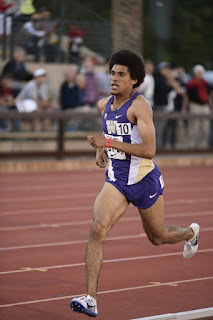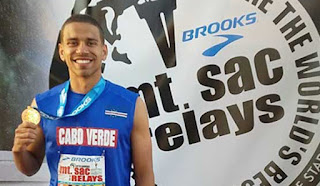My top track & field moments of the past decade (part 1)...
While the standards are still not as tough as it really should be (2:39/2:46, according to the USATF.org web site for the 2012 Trials, with 1:15 half-marathoners and 33;00.00 track 10000 times allowed in), there has been improvement at the top level (read—top 25) in the country, thanks in part to the funding of training groups like the Mammoth Track Club, Team USA/Minnesota, and McMillan Elite, among others.
With 2009 behind us now, I’m going to reflect in this two-part series on what I consider my top moments of the last ten years, as a prelude for what I hope will be a sign of things to come over the next ten years. Please note that one of the key criteria is witnessing it live in person, so anything from the 2008 Beijing Olympics is disqualified, most notably Usain Bolt's performances in the 100 and 200.
With so many outstanding marks, I don't think I could have done it justice by ranking 1-10, so I've decided to write it in chronological order.
I know I will miss several races/meets, but I will leave that up to the readers to decide.
TOP 10 RACES/PERFORMANCES WITNESSED IN PERSON (not necessarily because of times/marks):
Men’s 200m/Olympic Trials, Sacramento—Michael Johnson v. Maurice Greene:
The final race of the 2000 Olympic Trials in Sacramento, had all the elements of Ali-Frazier, Red Sox-Yankees, Inter Milan-AC Milan, Hatfields-McCoys, etc., thanks to some pre-race trash talking between Maurice Greene, who won the 100, and Michael Johnson, who won the 400.
In Northwest Runner, I wrote, Thanks to some woofing started by the Greene camp at last year’s nationals in Eugene alleging that Johnson faked an injury to get out of a widely anticipated race at 200 meters, countered by the Johnson camp questioning Greene’s maturity and ego, the year-long war of words was ending with the two racing each other for a spot on the Olympic team, live, and in prime time on NBC Sports (it was live on the east coast).
As one wag deftly commented, “All the trash talk and posturing between Mo and MJ over who’s gonna win could fill up all the garbage trucks in Sacramento”.
After all that posturing, the unexpected happened, as both Johnson and Greene pulled up lame. At the top of the curve, Johnson began to slow, hopped straight up, then collapsed in a heap, holding his cramped left hamstring.
Shortly after entering the homestretch, Greene, in contention despite drawing lane two, began limping, ran tentatively as he tried to decelerate, then slowly hobbled his way towards the finish line after straining his left hamstring.
That race made for great drama, and great television. Fortunately, both recovered from their injuries to win gold medals at the Sydney Olympics a few months later.
Snoqualmie’s Nick Rogers makes the 2000 Olympic team in the 5000:
I wrote in Northwest Runner, "Rogers, who dropped out of the men’s 10000 on the meet’s first night, made amends in the 5000 by taking the lead with three laps to go, knowing that he couldn’t have the race come down to a kick. Though he appeared to ease up near the finish with third place locked up, he nonetheless set a personal best of 13:29.48, .48 off the Olympic “A” standard, and a big drop from his previous best of 13:43.05.
Of the hard road he took to the medal stand here, including his checkered academic history at Eastern Washington and the University of Oregon, Rogers said: "It builds character, and I think I'm stronger for it. I'm not proud of it, but I think it made me a better person at the end. I learned a lot along the way."
After his race, Rogers said, he learned something new. "I think I'm one of the best American distance runners out there right now," he said.
At a post-meet party in Sacramento, Rogers expressed confidence that he’d exceed the Olympic “A” standard in Belgium two weeks after the Trials. Like pool legend Willie Mosconi calling the exact shot, Rogers took care of the last obstacle between him and his Olympic dream by dropping another 10.98 seconds from his PR, by running 13:18.50 at the Nacht van de Atletiek meet in Heusden, Belgium on August 5th."
Rogers finished 12th in his heat at the Sydney Olympics, then went on to make the 2001 World Cross Country Championships team and the 2001 World Championship team in the 5000.
Alan Webb takes down Jim Ryun’s national high school record in the mile at the Prefontaine Classic, May 27 2001:
 I wrote in Northwest Runner, "Every superlative describing high school phenom Alan Webb’s performance at the Pre was used after the young man from Reston, Virginia traveled one mile in 3:53.43, smashing one of the oldest American high school records in track and field history.
I wrote in Northwest Runner, "Every superlative describing high school phenom Alan Webb’s performance at the Pre was used after the young man from Reston, Virginia traveled one mile in 3:53.43, smashing one of the oldest American high school records in track and field history.
The only other word I can express after his performance is “WOW!”
Never mind the fact that two-time world champion and last year’s Olympic silver medalist Hicham El Guerrouj from Morocco broke the American all-comers record, running 3:49.92 to win the race from a quality field that included bronze medalist Bernard Lagat, the ex-WSU star from Kenya, and Canada’s Kevin Sullivan.
Never mind that all but one runner who finished the race broke the four-minute mile barrier. The fact of the matter is that Alan Webb broke Jim Ryun’s American high school record time of 3:55.3, set way back in 1964, and electrified a Hayward Field crowd of 11,221 in a way that it never has been since Steve Prefontaine raced on the hallowed Eugene oval.
From a personal level, seeing Alan Webb’s dash into history ranks up there with witnessing my first ever world record (Henry Rono’s 8:05.4 steeplechase in 1978 at Husky Stadium); Florence Griffith-Joyner’s 10.49 100-meter dash ten years later in Indianapolis; Mike Powell’s 29-4 1/2 long jump in the miso-soup like conditions at the 1991 Tokyo World Championships; Michael Johnson’s 43.18 400 in Seville two years ago; and, Joan Benoit’s courageous run in Olympia at the 1984 Marathon Trials.
"I was shooting for that high school record," said Webb, who became the first prep miler to run faster than 4 minutes since Marty Liquori did it in 1967 when he dashed off an indoor performance of 3:59.86 in January.
"I can run with these people," said Webb, who began the race as the trailer but "I was passing as many people as I could. I didn't know who I was passing, I just wanted to try and catch as many as I could. Now I want to try and beat some of these people."
Webb went on to run briefly at the University of Michigan, then turned pro. He made the 2004 Olympic team, and the 2005 & ’07 world championship team in the 1500. He struggled with his running the last two seasons, and is now training in Portland under coach Alberto Salazar.
Kenenisa Bekele’s development as the premier distance runner of this generation:
 At the 2001 World Cross Country Championships in Ostend, Belgium, you knew you were watching something special, when in a two-day time period, Ethiopia’s Kenenisa Bekele finished second in the men’s 4k race, then won the world junior 8k cross country title.
At the 2001 World Cross Country Championships in Ostend, Belgium, you knew you were watching something special, when in a two-day time period, Ethiopia’s Kenenisa Bekele finished second in the men’s 4k race, then won the world junior 8k cross country title.
After winning his first world title, he’s gone on to win eleven world cross country titles (including five titles at the now-discontinued 4k distance); five world track & field championships, primarily at 10000; and three Olympic titles.
Bekele’s position as a world sporting figure is right up there with cyclist Lance Armstrong, soccer star Lionel Messi, basketball’s Kobe Bryant, and swimmer Michael Phelps, among others.
Yelena Isinbayeva’s reign as queen of the pole vault:
 For the first part of the decade, the women’s pole vault was dominated primarily by American Stacy Dragila, who won world titles in 1999 and 2001, along with the first Olympic title in 2000.
For the first part of the decade, the women’s pole vault was dominated primarily by American Stacy Dragila, who won world titles in 1999 and 2001, along with the first Olympic title in 2000.
From July 2003, when she set her first world record at 4.82 meters (15-9 3/4), Russia’s Yelena Isinbayeva has been the most dominant pole vaulter in this relatively young track & field event, winning the last two Olympic titles, and three world titles along the way (Paris, Helsinki, and Osaka).
I had the pleasure of witnessing two successful world record attempts by Isi at the 2004 Olympics in Athens, and the 2005 World Championships in Helsinki, where she became the first woman to clear 5.00 meters (16-5).
Since 2003, she’s set 27 world records—both indoors and outdoors—and has been virtually undefeated from 2004 to 2009, where she was beaten twice by Poland’s Anna Rogowska, the most notable defeat coming at the world championships in Berlin, where she failed to clear a height.
Like Bekele, she has established herself as one of this generation’s premier athletes.
NOTE: Photos of Webb, Bekele & Isinbayeva by Paul Merca. Nick Rogers courtesy USA Track & Field.


Comments